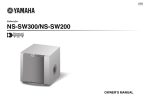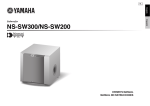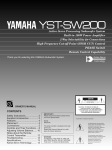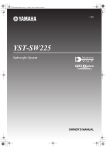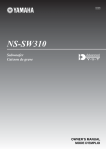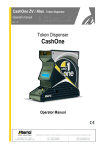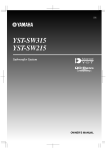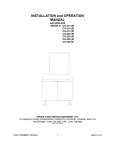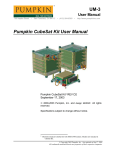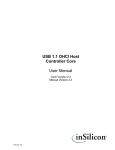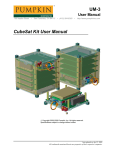Download Yamaha YST-SW500 Owner`s manual
Transcript
ABG English Français Subwoofer Caisson de grave NS-SW500 Deutsch Svenska Italiano Español Nederlands Русский OWNER’S MANUAL MODE D’EMPLOI BEDIENUNGSANLEITUNG BRUKSANVISNING MANUALE DI ISTRUZIONI MANUAL DE INSTRUCCIONES GEBRUIKSAANWIJZING Thank you for selecting this YAMAHA product. CAUTION: Read this before operating your unit Please read the following operating precautions before use. YAMAHA will not be held responsible for any damage and/or injury caused by not following the cautions below. • To assure the finest performance, please read this manual carefully. Keep it in a safe place for future reference. • Install this unit in a cool, dry, clean place - away from windows, heat sources, sources of excessive vibration, dust, moisture and cold. Avoid sources of humming (transformers, motors). To prevent fire or electrical shock, do not expose this unit to rain or water. • The voltage to be used must be the same as that specified on the rear panel. Using this unit with a higher voltage than specified is dangerous and may cause a fire and/or electric shock. • Do not use force on switches, controls or connection wires. When moving the unit, first disconnect the power plug and the wires connected to other equipment. Never pull the wires themselves. • When not planning to use this unit for a long period (ie., vacation, etc.), disconnect the AC power plug from the wall outlet. • To prevent lightning damage, disconnect the AC power plug when there is an electric storm. • Since this unit has a built-in power amplifier, heat will radiate from the rear panel. Place the unit apart from the walls, allowing at least 20 cm of space above, behind and on both sides of the unit to prevent fire or damage. Furthermore, do not position with the rear panel facing down on the floor or other surfaces. • Do not cover the rear panel of this unit with a newspaper, a tablecloth, a curtain, etc., in order not to obstruct heat radiation. If the temperature inside the unit rises, it may cause fire, damage to the unit and/or personal injury. • Do not place the following objects on this unit: - Glass, china, small metallic, etc. If glass, etc., falls as a result of vibrations and breaks, it may cause bodily injury. - A burning candle etc. If the candle falls as a result of vibration, it may cause fire and bodily injury. - A vessel containing water If the vessel falls as a result of vibration and water spills, it may cause damage to the speaker, and/or you may get an electric shock. i En • Do not place this unit where foreign material, such as dripping water. It might cause fire, damage to this unit, and/ or personal injury. • Never put a hand or a foreign object into the YST port located on the right side of this unit. When moving this unit, do not hold the port, as it might cause personal injury and/or damage to this unit. • Never place a fragile object near the YST port of this unit. If the object falls or drops as a result of the air pressure, it may cause damage to the unit and/or personal injury. • Never open the cabinet. It might cause an electric shock, since this unit uses a high voltage. It might also cause personal injury and/or damage to this unit. If something drops into the set, contact your dealer. • When using a humidifier, be sure to avoid condensation inside this unit by allowing enough space around this unit or avoiding excess humidification. Condensation might cause fire, damage to this unit, and/or electric shock. • Super-bass frequencies reproduced by this unit may cause a turntable to generate a howling sound. In such a case, move this unit away from the turntable. • This unit may be damaged if certain sounds are continuously output at high volume level. For example, if 20 Hz-50 Hz sine waves from a test disc, bass sounds from electronic instruments, etc., are continuously output, or when the stylus of a turntable touches the surface of a disc, reduce the volume level to prevent this unit from being damaged. • If you hear distortion (i.e., unnatural, intermittent “rapping” or “hammering” sounds) coming from this unit, reduce the volume level. Extremely loud playing of a movie soundtrack’s low frequency, bass-heavy sounds or similarly loud popular music passages can damage this speaker system. • Vibration generated by super-bass frequencies may distort images on a TV. In such a case, move this unit away from the TV set. • Do not attempt to clean this unit with chemical solvents as this might damage the finish. Use a clean, dry cloth. • Be sure to read the “TROUBLESHOOTING” section regarding common operating errors before concluding that the unit is faulty. • Install this unit near the wall outlet and where the AC power plug can be reached easily. • Secure placement or installation is the owner’s responsibility. YAMAHA shall not be liable for any accident caused by improper placement or installation of speakers. • VOLTAGE SELECTOR (Asia and General models only) The voltage selector switch on the rear panel of this unit must be set to your local main voltage BEFORE plugging this unit into the AC main supply. Voltages are 110-120 V/220-240 V. WARNING TO REDUCE THE RISK OF FIRE OR ELECTRIC SHOCK, DO NOT EXPOSE THIS APPLIANCE TO RAIN OR MOISTURE. This unit is not disconnected from the AC power source as long as it is connected to the wall outlet, even if this unit itself is turned off. In this state, this unit is designed to consume a very small quantity of power. For U.K. customers If the socket outlets in the home are not suitable for the plug supplied with this appliance, it should be cut off and an appropriate 3 pin plug fitted. For details, refer to the instructions described below. Note: The plug severed from the mains lead must be destroyed, as a plug with bared flexible cord is hazardous if engaged in a live socket outlet. SPECIAL INSTRUCTIONS FOR U.K. MODEL IMPORTANT: THE WIRES IN MAINS LEAD ARE COLOURED IN ACCORDANCE WITH THE FOLLOWING CODE: Blue: NEUTRAL Brown: LIVE As the colours of the wires in the mains lead of this apparatus may not correspond with the coloured markings identifying the terminals in your plug, proceed as follows: The wire which is coloured BLUE must be connected to the terminal which is marked with the letter N or coloured BLACK. The wire which is coloured BROWN must be connected to the terminal which is marked with the letter L or coloured RED. Make sure that neither wire is connected to the earth terminal of a three pin plug. Thank you for having chosen a Yamaha product. In the unlikely event that your Yamaha product needs guarantee service, please contact the dealer from whom it was purchased. If you experience any difficulty, please contact Yamaha representative office in your country. You can find full details on our website (http://www.yamaha-hifi.com/ or http:// www.yamaha-uk.com/ for U.K. resident). The product is guaranteed to be free from defects in workmanship or materials for a period of two years from the date of the original purchase. Yamaha undertakes, subject to the conditions listed below, to have the faulty product or any part(s) repaired, or replaced at Yamaha’s discretion, without any charge for parts or labour. Yamaha reserves the right to replace a product with that of a similar kind and/or value and condition, where a model has been discontinued or is considered uneconomic to repair. Conditions 1. The original invoice or sales receipt (showing date of purchase, product code and dealer’s name) MUST accompany the defective product, along with a statement detailing the fault. In the absence of this clear proof of purchase, Yamaha reserves the right to refuse to provide free of charge service and the product may be returned at the customer’s expense. 2. The product MUST have been purchased from an AUTHORISED Yamaha dealer within the European Economic Area (EEA) or Switzerland. 3. The product must not have been the subject of any modifications or alterations, unless authorised in writing by Yamaha. 4. The following are excluded from this guarantee: a. Periodic maintenance and repair or replacement of parts due to normal wear and tear. b. Damage resulting from: (1) Repairs performed by the customer himself or by an unauthorised third party. (2) Inadequate packaging or mishandling, when the product is in transit from the customer. Please note that it is the customer’s responsibility to ensure the product is adequately packaged when returning the product for repair. (3) Misuse, including but not limited to (a) failure to use the product for its normal purpose or in accordance with Yamaha’s instructions on the proper use, maintenance and storage, and (b) installation or use of the product in a manner inconsistent with the technical or safety standards in force in the country where it is used. (4) Accidents, lightning, water, fire, improper ventilation, battery leakage or any cause beyond Yamaha’s control. (5) Defects of the system into which this product is incorporated and/ or incompatibility with third party products. (6) Use of a product imported into the EEA and/or Switzerland, not by Yamaha, where that product does not conform to the technical or safety standards of the country of use and/or to the standard specification of a product sold by Yamaha in the EEA and/or Switzerland. 5. Where the guarantee differs between the country of purchase and the country of use of the product, the guarantee of the country of use shall apply. 6. Yamaha may not be held responsible for any losses or damages, whether direct, consequential or otherwise, save for the repair or replacement of the product. 7. Please backup any custom settings or data, as Yamaha may not be held responsible for any alteration or loss to such settings or data. 8. This guarantee does not affect the consumer’s statutory rights under applicable national laws in force or the consumer’s rights against the dealer arising from their sales/purchase contract Information for Users on Collection and Disposal of Old Equipment This symbol on the products, packaging, and/ or accompanying documents means that used electrical and electronic products should not be mixed with general household waste. For proper treatment, recovery and recycling of old products, please take them to applicable collection points, in accordance with your national legislation and the Directives 2002/ 96/EC. By disposing of these products correctly, you will help to save valuable resources and prevent any potential negative effects on human health and the environment which could otherwise arise from inappropriate waste handling. For more information about collection and recycling of old products, please contact your local municipality, your waste disposal service or the point of sale where you purchased the items. [Information on Disposal in other Countries outside the European Union] This symbol is only valid in the European Union. If you wish to discard these items, please contact your local authorities or dealer and ask for the correct method of disposal. CONTENTS FEATURES......................................................................1 SUPPLIED ACCESSORY..............................................1 PLACEMENT .................................................................1 Subwoofer orientation.................................................1 CONTROLS AND THEIR FUNCTIONS .....................2 CONNECTIONS.............................................................3 1 Connecting to line output (pin jack) terminal(s) of the amplifier.......................................................3 2 Connecting to speaker output terminals of the amplifier.......................................................4 Connecting to the INPUT1/OUTPUT terminals of the subwoofer ....................................................................4 SYSTEM CONNECTIONS .......................................5 Plugging the subwoofer into an AC outlet ........................5 AUTOMATIC POWER-SWITCHING FUNCTION ...........5 Setting the AUTO STANDBY switch ........................5 ADJUSTING THE BALANCE......................................6 Subwoofer frequency characteristics ..........................7 ADVANCED YAMAHA ACTIVE SERVO TECHNOLOGY II .........................................................7 TROUBLESHOOTING..................................................8 SPECIFICATIONS .........................................................8 Taking care of the speaker To maintain the spotless glossy surface of the polished finish, wipe it with a soft, dry cloth. To avoid damage to the finish, do not apply chemical solvents, such as alcohol, benzine, thinner, insecticide, etc. Also, do not use a damp cloth, or any type of cloth that contains chemical solvents, or place a plastic or vinyl sheet on top of the speaker. Otherwise, the finish may peel, the color may fade, or the sheet may stick to the surface. Yamaha recommends that you use a Yamaha Unicon cloth (sold separately). For heavy dirt, use a Yamaha Piano Unicon (sold separately). You can purchase a Yamaha Unicon cloth and Piano Unicon at your nearest Yamaha dealer. ii En English Limited Guarantee for European Economic Area (EEA) and Switzerland FEATURES PLACEMENT • This subwoofer system employs Advanced Yamaha Active Servo Technology II, which Yamaha has developed for the production of higher quality, superbass sound. (Refer to page 7 for details on Advanced Yamaha Active Servo Technology II.) This super-bass sound adds a more realistic, theater-in-the-home effect to your stereo system. • This subwoofer can easily be added to your existing audio system by connecting to either the speaker terminals or the line output (pin jack) terminals of the amplifier. • For effective use of the subwoofer, the subwoofer’s super-bass sound should be matched to the sounds of your front speakers. You can create the best sound quality for various listening conditions by using the HIGH CUT control and the PHASE switch. • The Automatic power-switching function saves you the trouble of pressing the power switch to turn the power on and off. • The subwoofer can be linked to a Yamaha component for simultaneous power on/off operation. Use the supplied system control cable to connect the subwoofer to a Yamaha component that features a system connector jack. When you turn on or off the power to the connected component, the subwoofer will also be turned on or off. • You can select a bass effect suitable for the source by using the B.A.S.S. switch. • This subwoofer system is equipped with a linear port unique to Yamaha that provides smooth bass response during playback, minimizing extraneous noise not included in the original input signal. Since the low-end frequencies of audio signals feature long wavelengths, they are almost non-directional to human ears. The super-bass range does not create a stereo image. Therefore, a single subwoofer may be enough to produce a highquality super-bass sound. However, using two subwoofers (similarly to L and R front speakers) can enhance your acoustic experience. SUPPLIED ACCESSORY After unpacking, check that the following accessory is contained. System control cable (5 m x 1) 1 En Notes • This unit features a magnetically shielded design. However, there is still a chance that placing it too close to a CRT-type TV set might impair picture color. Should this happen, move this unit away from the TV set. • If the speaker volume is very loud, furniture or window glass may resonate and the subwoofer itself may vibrate. In this case, lower the volume level. To limit resonance, use a thick curtain or similar cloth that tends to absorb sound vibrations effectively. Also, changing the subwoofer position may be helpful. Subwoofer orientation Place the subwoofer as shown in fig. : subwoofer A A or B for the optimum effect. : front speaker Using one subwoofer Place the subwoofer on the outside of either the left or right front speaker. The placement shown in fig. C is also possible. However, if the subwoofer system is placed directly facing the wall, the bass effect may suffer due to cancellation of direct and reflected sounds. To prevent this from happening, place the subwoofer system at an angle, as in fig. A or B . C B Using two subwoofers Place them on the outside of each front speaker. Note There may be a case that you cannot obtain enough super-bass sound from the subwoofer due to standing waves. 1 Indicator 1 Green: The subwoofer is turned on. Red: The Automatic power-switching function has activated, and the subwoofer is in standby mode. The subwoofer is turned off. Off: Top panel 2 Port Outputs super-bass sound. 3 OUTPUT (TO SPEAKERS) terminals ( page 3) Can be used for connecting to the main speakers. Signals from the INPUT1 terminals are sent to these terminals. 2 Front panel 4 INPUT2 (NORMAL) terminals ( page 3) Used to input line level signals from the amplifier. 3 5 INPUT3 (LFE) terminals ( page 3) The HIGH CUT control ! has no effect on the signals input to these terminals. 6 4 5 7 8 9 ) 6 SYSTEM CONNECTOR jack ( page 5) Connect the supplied system control cable here. If you use the system control cable to connect a subwoofer to a Yamaha component (that features a system connector jack), turning on or off the power to the connected component automatically turns the subwoofer on or off. 7 INPUT1 (FROM AMPLIFIER) terminals ( page 4) Used to connect the subwoofer with the speaker terminals of the amplifier. ! # Rear panel @ 8 AUTO STANDBY (HIGH/LOW/OFF) switch ( page 5) This switch is originally set to the OFF position. By setting this switch to the HIGH or LOW position, the subwoofer’s automatic power-switching function operates. If you do not need this function, leave this switch in the OFF position. Note Be sure to set the POWER switch to OFF before you set the AUTO STANDBY switch. 9 PHASE switch ( page 6) This switch is to be set to the REV (reverse) position. However, depending on your speaker system or listening conditions, there may be a case when better sound quality is obtained by setting this switch to the NORM (normal) position. Select the best position by ear. ) B.A.S.S. (Bass Action Selector System) switch ( page 6) When this switch is set to MUSIC, the bass sound in audio software is well reproduced. When the switch is set to MOVIE, the bass sound in video software is well reproduced. ! HIGH CUT control ( page 6) Adjusts the high frequency cut off point. Frequencies higher than the frequency selected by graduation this control are all cut off * One of this control represents 10 Hz. (and not output). @ VOLUME control Adjusts the volume level. Turn the control clockwise to increase the volume, and counterclockwise to decrease the volume. # POWER switch During normal usage, set this switch to ON. If you plan not to use the subwoofer for a long period of time, set the switch to OFF. 2 En English CONTROLS AND THEIR FUNCTIONS CONNECTIONS Choose one of the following connection methods most suitable for your audio system. 1 Choose this method if your amplifier has line output (pin jack) terminal(s). ( this page) 2 Choose this method if your amplifier has no line output (pin jack) terminals. ( page 4) 1 Audio signals input from the Notes • Unplug the subwoofer and other audio/video components before making connections, and do not plug them in until all connections are completed. • Connecting methods and terminal names on your component (such as an amplifier or receiver) may be different from those used in this book. Please refer to the owner’s manual that came with your component. • All connections must be correct, that is to say L (left) to L; R (right) to R; “+” to “+” and “–” to “–”. Connecting to line output (pin jack) terminal(s) of the amplifier /MONO and INPUT 2 terminals on the subwoofer will not be output from the OUTPUT (TO SPEAKERS) terminals. Example: Connecting one subwoofer Example: Connecting two subwoofers Use a commercially-available Mono pin cable 1 or a commercially-available Audio pin cable 2 to make the connections. • Connect the SUBWOOFER (or LOW PASS, etc.) terminal on the rear of the amplifier (or AV receiver) to the /MONO INPUT2 terminal of the subwoofer using a commercially-available Mono pin cable 1. Alternatively, • When connecting the subwoofer to the SPLIT SUBWOOFER terminals (featuring L and R channels) on the rear panel of the amplifier, use a commercially-available Audio pin /MONO INPUT2 terminal to the “L” side, and the cable 2 to connect the INPUT2 terminal to the “R” side of the SPLIT SUBWOOFER terminals. Subwoofer Subwoofer To AC outlet To AC outlet 1 Mono pin cable Subwoofer Amplifier or receiver Connecting to the INPUT3 (LFE) terminal(s) To AC outlet 1 Mono pin cable Amplifier or receiver 3 En 2 Audio pin cable If your amplifier can cut off high frequencies from signals sent to the subwoofer, connect the amplifier to the subwoofer’s INPUT3 (LFE) terminal(s). This will promote higher sound quality because the signal routing in the subwoofer is shortened by passing the built-in HIGH CUT circuit. 1 Mono pin cable Connecting to speaker output terminals of the amplifier ■ Example: Connecting the subwoofer to an amplifier that features one set of speaker output terminals Use speaker cables to connect the speaker output terminals of the amplifier to the subwoofer’s INPUT 1 (FROM AMPLIFIER) terminals. Connect the front speakers to the subwoofer’s OUTPUT (TO SPEAKERS) terminals. Although the subwoofer is connected between the front speakers and the amplifier, the sound volume or quality will not be affected. ■ Example: Connecting the subwoofer to an amplifier featuring two sets of speaker output terminals (A and B) that can output sound signals simultaneously Set the amplifier so that both sets of speaker output terminals (A and B) will output sound signals simultaneously. Then, connect the front speakers to terminals A, and connect the subwoofer to terminals B. Note If your amplifier features two sets of speaker output terminals that do NOT output sound signals simultaneously, please refer to the example for connecting an amplifier that has only one set of speaker output terminals (see the figure on the left). Connecting one subwoofer Connecting to the INPUT1/OUTPUT terminals of the subwoofer ■ Before connecting Subwoofer Remove 10 mm (3/8") of insulation from the ends of the speaker cables. Right front speaker Left front speaker To AC outlet Amplifier or receiver 10 mm (3/8") Good ■ How to connect 1. Loosen the terminal’s knob, as shown in the figure. 1 2. Insert the bare wire. Speaker output terminals 3. Tighten the knob. Red: positive (+) 4. Test the firmness of the connection by pulling lightly Black: negative (–) on the cable at the terminal. No Good 2 3 Connecting two subwoofers ■ Connecting the banana plug 1. Tighten the terminal knob. 2. Simply insert the banana plug into the terminal. Right front speaker Left front speaker Subwoofer Speaker output terminals Subwoofer Amplifier or receiver To AC outlet To AC outlet 1 2 Notes • Make sure that the “+” and “–” polarity markings of the speaker cables are observed and set correctly. If these cables are reversed, the sound will be unnatural and lack bass. • Do not let the bare speaker wires touch each other, because this could damage the subwoofer or the amplifier. • If the connections are faulty, no sound will be heard from the subwoofer or the speakers. Do not insert the insulation into the hole. Sound may not be produced. • To avoid accidents resulting from tripping over loose speaker cables, fix them to the floor. 4 En English 2 SYSTEM CONNECTIONS AUTOMATIC POWER-SWITCHING FUNCTION If you use the supplied system control cable to connect a subwoofer to a Yamaha component (e.g., Yamaha Digital Sound Projector that features a system connector jack), turning on or off the power to the connected component automatically turns the subwoofer on or off. This function automatically places the subwoofer in standby mode if the subwoofer does not detect a signal from the amplifier for a certain period of time. The subwoofer automatically turns on as soon as it detects a signal from the amplifier. The Automatic power-switching function works as follows when the AUTO STANDBY (HIGH/LOW/OFF) switch is set to LOW or HIGH. (Normally, set the switch to LOW.) ■ Connection example How the Automatic power-switching function works Yamaha Digital Sound Projector The subwoofer automatically enters standby mode if it does not receive an input signal (*1) from the amplifier for 7 or 8 minutes (*2). * The indicator color changes from green to red. Subwoofer Supplied system control cable When the subwoofer detects an input signal (*1) from the amplifier, the subwoofer automatically turns on. * The indicator color changes from red to green. How the System Connection works Turning on the power to the connected component will automatically turn on the subwoofer. * The indicator lights green. *1 When the Automatic power-switching function is enabled, the subwoofer will detect a bass signal input of below 200Hz (such as sound effects of explosion in action movies, bass guitar or bass drum sound, etc.). *2 This value may vary depending on the system environment. For example, it may be affected by noise generated from other equipment. Note The Automatic power-switching function is available only when the POWER switch is set to ON. Turning off the power to the connected component will automatically turn off the subwoofer. * The indicator turns off. Notes • For this feature to be available, the POWER switch on the subwoofer must be set to ON. • Powering on/off via the system connection takes priority over the Automatic power-switching function. (While the unit is turned on, the Automatic power-switching function is enabled.) • To modify the settings of the connected components, please refer to the owner’s manual that came with the respective component. Plugging the subwoofer into an AC outlet After all connections are completed, plug the subwoofer and other audio/video components into AC outlets. Setting the AUTO STANDBY switch Note Be sure to set the POWER switch to OFF before you set the AUTO STANDBY switch. LOW: The Automatic power-switching function activates at a certain level of input signal. To enable the function, select this position. HIGH:If the Automatic power-switching function does not work well when the AUTO STANDBY switch is set to LOW, select this position. If the function still does not work, slightly raise the LFE LEVEL on the amplifier. OFF: The Automatic power-switchingy function may unexpectedly activate due to the system environment, for example, if the subwoofer detects noise generated from the peripheral components. In this case, select this position to disable the Automatic powerswitching function, and manually turn the unit on or off by using the POWER switch. Notes • The subwoofer uses a small amount of power in auto-standby mode. • If you plan not to use the subwoofer for a long period of time, set the POWER switch on the rear panel to OFF, or unplug the power cable from the AC outlet. To AC outlet 5 En English ADJUSTING THE BALANCE To achieve natural sound with an effective super-bass component, you must adjust the volume and tone balance between the subwoofer and the front speakers. Follow the procedure described below. 4. Play a source that contains low-frequency components and adjust the output level of the front speakers using the amplifier’s volume control to the desired listening level. (Set all tone controls to flat.) 5. Adjust the HIGH CUT control to the position where the desired response can be obtained. Normally, set the control to a level a little higher than the front speaker’s rated minimum reproducible frequency*. PHASE switch In most situations, set this switch to select the reverse mode. However, depending on your speaker systems or listening condition, there may be a case when better sound quality is obtained by selecting the normal mode. Select the better mode by monitoring the sound. * The front speaker’s rated minimum reproducible frequency can be looked up in the speakers’ catalog or owner’s manual. * The HIGH CUT control has no effect on signals input to the INPUT 3 LFE terminals. 6. Increase the volume gradually to adjust the volume balance between the subwoofer and the front speakers. Normally, set the control to a level where you can obtain a little more bass effect than when the subwoofer is not used. 7. Set the PHASE switch to the position which yields the more natural (or preferable) phasing. 8. Set the B.A.S.S. switch to “MOVIE” or “MUSIC” Rear panel 1. Set the VOLUME control to minimum (0). 2. Turn on the power to the component(s) connected to the subwoofer. If the component is connected to the subwoofer’s SYSTEM CONNECTOR jack, turn on the power to that component. 3. Set the POWER switch on the subwoofer to ON. * The indicator lights green. according to the played source. MOVIE: When a movie type source is played, the low-frequency effects are enhanced to allow listeners to enjoy a more powerful sound. (The sound will be richer and deeper.) MUSIC: When an ordinary music source is played, the excessive low-frequency components are cut off to make the sound clearer. (The sound will carry less bass and reproduce the melody line more clearly.) Note Once the volume balance between the subwoofer and the front speakers is adjusted, you can adjust the volume of your entire sound system by using the amplifier’s volume control. However, if you replace the front speakers, you will need to make this adjustment again. 6 En Subwoofer frequency characteristics The figures below show the optimum adjustment of each control and the frequency characteristics when the subwoofer is combined with a typical front speaker system. HIGH CUT 40 Hz HIGH CUT 90 Hz HIGH CUT 140 Hz dB 90 ■ When combined with 10 cm (4") or 13 cm (5") acoustic suspension, 2-way system front speakers PHASE dB 90 80 (70 Hz) (REV) 70 80 60 70 50 60 40 20 50 100 200 500Hz Frequency response graph* 50 40 20 Front speaker 50 100 200 500Hz ■ When combined with 20 cm (8") or 25 cm (10") acoustic suspension, 2-way system front speakers dB PHASE 90 80 (50 Hz) (REV) 70 60 ADVANCED YAMAHA ACTIVE SERVO TECHNOLOGY II In 1988, Yamaha brought to the marketplace speaker systems utilizing YST (Yamaha Active Servo Technology) to give powerful, high quality bass reproduction. This technique uses a direct connection between the amplifier and speaker, allowing accurate signal transmission and precise speaker control. As this technology uses speaker units controlled by the negative impedance drive of the amplifier and resonance generated between the speaker cabinet volume and port, it creates more resonant energy (the “air woofer” concept) than the standard bass reflex method. This allows for bass reproduction from much smaller cabinets than was previously possible. Yamaha’s newly developed Advanced YST II adds many refinements to Yamaha Active Servo Technology, allowing better control of the forces driving the amplifier and speaker. From the amplifier’s point of view, the speaker impedance changes depending on the sound frequency. Yamaha developed a new circuit design combining negative-impedance and constant-current drives, which provides a more stable performance and clear bass reproduction, without any murkiness. Front speaker Cabinet 50 40 20 50 100 200 500Hz Frequency response graph* * This diagram does not depict actual frequency response characteristics. Port Highamplitude bass sound Air woofer (Helmholtz resonator) Advanced impedance Converter Active Servo Processing Amplifier Signals of low amplitude 7 En Signals Refer to the chart below if this unit does not function properly. If the problem you are experiencing is not listed below, or if the instructions given below do not help, disconnect the power cord and contact an authorized YAMAHA dealer or service center. Problem Cause What to Do Power is not supplied even though the POWER switch is set to the ON position. The power plug is not securely connected. Connect it securely. The subwoofer does not turn on automatically via the system connection. The system control cable is not connected properly or securely. Connect the system control cable properly. The POWER switch is set to OFF. Set the POWER switch to ON. No sound. The volume is set to minimum. Increase the volume. Speaker cables are not connected securely. Connect speaker cables securely. Speaker cables are not connected correctly. Connect them correctly, that is L (left) to L; R (right) to R; “+” to “+” and “–” to “–”. The PHASE switch is not set correctly. Set the PHASE switch to the other position. A source sound with little bass frequency content is being played. Play a source sound with bass frequencies. Set the HIGH CUT control to a higher position. The sound is influenced by standing waves. Reposition the subwoofer or break up parallel surfaces by placing bookshelves, etc., along the walls. The POWER switch is set to the OFF position. Set the POWER switch to the ON position. The AUTO STANDBY switch is set to the OFF position. Set the AUTO STANDBY switch to the HIGH or LOW position. The level of input signal is too low. Set the AUTO STANDBY switch to the HIGH position, and increase the output level of the amplifier. No bass frequency content is being output from the amplifier. Check the bass output setting of the amplifier. Sound level is too low. The subwoofer does not turn on automatically. Problem Cause What to Do The subwoofer does not enter standby mode automatically. Noise generated from external appliances etc., is activating the subwoofer. Move the subwoofer farther away from such appliances, and/or reposition the connected speaker cables. Set the AUTO STANDBY switch to the HIGH or LOW position. The AUTO STANDBY switch is set to the OFF position. Set the AUTO STANDBY switch to the HIGH or LOW position. The subwoofer enters standby mode unexpectedly. The level of input signal is too low. Set the AUTO STANDBY switch to the HIGH position, and increase the output level of the amplifier. The subwoofer turns on unexpectedly. Noise generated from external appliances etc., is activating the subwoofer. Move the subwoofer farther away from such appliances, and/ or reposition the connected speaker cables. If the AUTO STANDBY switch is set to HIGH, set it to LOW. Alternatively, set the AUTO STANDBY switch to the OFF position. SPECIFICATIONS Type ............................................................. Advanced Yamaha Active Servo Technology Driver ........................................................................................... 25 cm (10") cone woofer Magnetic shielding type Amplifier Output (100 Hz, 5 ohms, 10% THD) .................................................... 250 W Frequency Response .................................................................................. 20 Hz - 160 Hz Power Supply U.K. and Europe models ...................................................................... AC 230 V, 50 Hz Australia model .................................................................................... AC 240 V, 50 Hz China model ......................................................................................... AC 220 V, 50 Hz Asia and General models ......................................... AC 110-120/220-240 V, 50/60 Hz Power Consumption................................................................................................... 80 W Standby Power Consumption ...................................................................... 0.3 W or less Dimensions (W × H × D)......................... 380 × 368 × 420 mm (15" × 14-1/2" × 16-1/2") Weight ............................................................................................. 18.5 kg (40 lbs. 13 oz.) Please note that all specifications are subject to change without notice. 8 En English TROUBLESHOOTING ТЕХНИЧЕСКИЕ ХАРАКТЕРИСТИКИ Тип........................................... технология Advanced Yamaha Active Servo Technology Динамик .................................................................. конического типа диаметром 25 см с магнитным экранированием Выход с усилителя (100 Гц, 5 Ом, суммарное значение коэффициента нелинейных искажений 10%) ..............................................................................250 Вт Частотная характеристика............................................................................ 20–160 Гц Питание Модели для Великобритании и Европы.............................. 230 В перем. тока 50 Гц Модель для Австралии ......................................................... 240 В перем. тока 50 Гц Модель для Китая.................................................................. 220 В перем. тока 50 Гц Модели для Азии и общие модели ......... 110–120/220–240 В перем. тока 50/60 Гц Потребление энергии ...............................................................................................80 Вт Потребление энергии в режиме ожидания ......................................... не более 0,3 Вт Габаритные размеры (Ш × В × Г) ................................................. 380 × 368 × 420 мм Масса........................................................................................................................ 18,5 кг Обратите внимание, что все характеристики могут изменяться без уведомления. © 2010 Yamaha Corporation Printed in Indonesia WV17030












